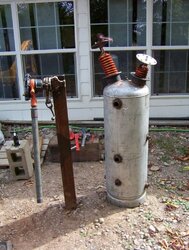For those of you with hydronic plumbing experience, I am looking for feedback on how to connect my wood boiler through buffer tanks in parallel to a gas LPG backup boiler to heat radiant floor and DHW hot water indirectly. I intend to fire the wood a majority of the time and expect the gas backup to only run during times we fail to feed the flame or during mild seasons for hot water, etc.
Look at my preliminary schematic plan below... Is this piping simple enough to install and maintain myself yet flexible enough to buffer both and alternate heating source automatically?
I'm aiming for a common low-loss header (or similar closely spaced Ts as in primary/secondary piping) that can route the hot water from either boiler, as needed, based on smart control wiring.
My original question at the Heating Help forum:<http://www.heatinghelp.com/forum-th...ckup-via-reverse-indirect-BUFFER-tank/success>
Bear with me as this is my first time posting ... I will reply back to add more info on my house and system if it helps bring more constructive comments. (hope that works...)
Thank you in advance.
Look at my preliminary schematic plan below... Is this piping simple enough to install and maintain myself yet flexible enough to buffer both and alternate heating source automatically?
I'm aiming for a common low-loss header (or similar closely spaced Ts as in primary/secondary piping) that can route the hot water from either boiler, as needed, based on smart control wiring.
My original question at the Heating Help forum:<http://www.heatinghelp.com/forum-th...ckup-via-reverse-indirect-BUFFER-tank/success>
Bear with me as this is my first time posting ... I will reply back to add more info on my house and system if it helps bring more constructive comments. (hope that works...)
Thank you in advance.








